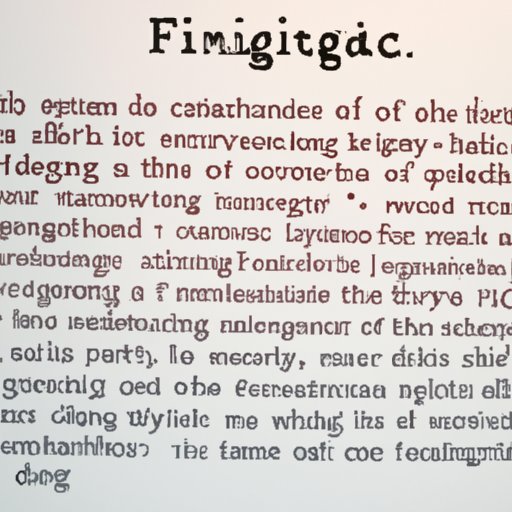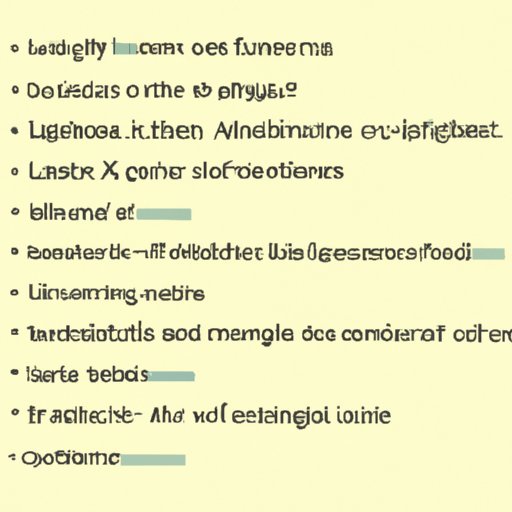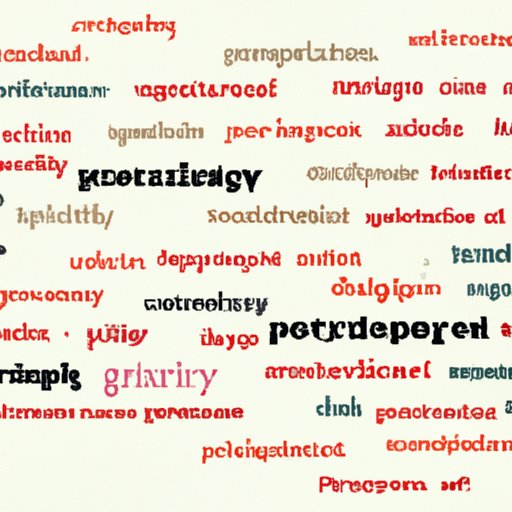Introduction
Figurative writing is a type of writing that uses figures of speech to express ideas and convey meaning. It can be used to create vivid images and help readers better understand the text. While it may seem intimidating at first, with some practice and guidance anyone can become skilled in this type of writing.

Exploring the Meaning of Figurative Writing
In order to understand what figurative writing is, it’s important to first understand the definition and purpose of figurative language. Figurative language is a type of language that is used to express ideas or feelings that are not literal. It often uses metaphors, similes, personification, hyperbole, and other literary devices to make a point or evoke an emotion. By using figurative language, writers are able to create vivid images and stories that are more interesting and engaging than those created with literal language.
There are several different types of figurative language that can be used in writing. Metaphors are comparisons between two unlike things without using the words “like” or “as.” For example, “the world is a stage.” Similes are similar to metaphors, but they use the words “like” or “as” to compare two unlike things. For example, “she sang like a nightingale.” Personification is when human characteristics are given to non-human things. For example, “the wind whispered secrets.” Hyperbole is when something is exaggerated for effect. For example, “I’ve told you a million times.” Alliteration is when a series of words begin with the same sound. For example, “Peter Piper picked a peck of pickled peppers.”
A Guide to Using Figurative Language in Writing
Now that you know the basic types of figurative language, you can start practicing using them in your own writing. Here are some tips for crafting effective metaphors and similes:
Metaphors
When creating metaphors, think of two things that have an unexpected connection and use that to explain or describe something. Be sure to avoid clichés and try to come up with something original and creative. Also, make sure the metaphor is clear and easy to understand so that your readers don’t get confused.
Similes
When writing similes, think of two things that share some kind of similarity and use that to explain or describe something. Again, try to avoid clichés and come up with something original and creative. Also, make sure the simile is clear and easy to understand so that your readers don’t get confused.
Personification
When using personification, think of a non-human object and give it human traits or characteristics. This can be done by describing the object as if it were alive or could talk. Be sure to use vivid imagery and descriptive language to bring the object to life and make it more relatable to the reader.
Hyperbole
When using hyperbole, exaggerate something for dramatic effect. This can be done by making something seem bigger or better than it actually is. Just be sure to use it sparingly, as too much exaggeration can make your writing seem unbelievable or overdone.
Alliteration
When using alliteration, create a string of words that share the same beginning sound. This can be done by repeating the same sound or letter at the beginning of each word. Just be sure to make sure the words flow together and make sense so that your readers can easily understand your writing.

Crafting Creative Metaphors and Similes
Now that you know the basics of figurative language, it’s time to start crafting creative metaphors and similes. Here are some tips for getting started:
Brainstorming Ideas
The first step to crafting creative metaphors and similes is to brainstorm ideas. Think of two things that have an unexpected connection or share some kind of similarity. This can be anything from animals to objects to emotions. Once you have an idea of what you want to write about, you can start thinking of ways to express it in a unique and interesting way.
Writing Techniques
Once you have a good idea of what you want to write about, the next step is to decide how you want to express it. Think about what words and phrases will best capture the image or feeling that you’re trying to convey. Use vivid imagery and descriptive language to help bring your writing to life. And remember to keep it simple and clear so that your readers can easily understand your writing.

How to Use Imagery to Enhance Your Writing
Imagery is an important part of figurative writing, as it helps bring the text to life and makes it more interesting and engaging. Here are some tips for using imagery to enhance your writing:
Describing Scenes and Objects
When describing scenes and objects, think of the five senses: sight, smell, taste, touch, and sound. Try to incorporate all five senses into your descriptions so that your readers can really feel like they’re there. Use vivid imagery and descriptive language to help bring the scene or object to life.
Creating Engaging Visuals
When creating visuals, think about what images will best capture the mood or feeling that you’re trying to convey. Use colors, shapes, and lines to create interesting visuals that will draw readers in and keep them engaged. Also, be sure to use imagery that is relevant to the text so that it enhances rather than detracts from the overall message.
Tips for Writing with Figurative Language
Now that you know the basics of figurative writing, here are some tips for using it effectively:
Finding the Right Balance
It’s important to find the right balance when using figurative language. Too much can make your writing seem overdone and forced, while too little can make it seem dull and uninteresting. Aim for a balance that is neither too heavy nor too light so that your writing has just enough figurative language to make it interesting and engaging.
Being Clear and Precise
When using figurative language, it’s important to be clear and precise. Make sure your metaphors and similes are clear and easy to understand so that your readers don’t get confused. Also, be sure to use precise language so that your writing doesn’t become muddled or unclear.

Examples of Figurative Language in Literature
Figurative language has been used in literature for centuries. Here are a few examples of famous authors who have used figurative language in their works:
William Shakespeare
William Shakespeare was a master of figurative language. He used metaphors, similes, personification, and other devices to create vivid images and express complex ideas. One of his most famous quotes is “all the world’s a stage,” which is a metaphor comparing the world to a theater.
T.S. Eliot
T.S. Eliot was another master of figurative language. His poem The Waste Land is full of metaphors, similes, and other literary devices. He also used imagery to create vivid visuals that help bring the poem to life. One of his most famous lines is “April is the cruelest month,” which is a metaphor comparing April to a cruel person.
Mary Shelley
Mary Shelley was a pioneer of Gothic literature and was known for her use of figurative language. In her novel Frankenstein, she uses metaphors, similes, and personification to create an eerie and suspenseful atmosphere. One of her most famous lines is “it was on a dreary night of November,” which is a metaphor comparing the night to a dreary landscape.
Analyzing Figurative Writing in Poetry
When analyzing figurative writing in poetry, it’s important to recognize common devices such as metaphors, similes, and personification. These devices can be used to create vivid images and help convey the theme of the poem. It’s also important to examine the imagery used in the poem and how it relates to the theme. By doing this, you can gain a better understanding of the poem and its meaning.
Conclusion
Figurative writing is a powerful tool that can be used to create vivid images and express complex ideas. By understanding the basics of figurative language and how to craft creative metaphors and similes, you can become a skilled writer and use figurative language to enhance your writing. You can also use figurative language to analyze literature and poetry and gain a better understanding of the text.
Summary of Topics
This comprehensive guide explored what figurative writing is, the different types of figurative language, and how to use it effectively in your own writing. It also covered tips for crafting creative metaphors and similes, using imagery to enhance your writing, and analyzing figurative writing in literature and poetry.
Final Thoughts
Figurative writing is an art form that takes practice and dedication to master. With some guidance and patience, anyone can become skilled in this type of writing and use it to create vivid images and stories that are more interesting and engaging than those created with literal language.
(Note: Is this article not meeting your expectations? Do you have knowledge or insights to share? Unlock new opportunities and expand your reach by joining our authors team. Click Registration to join us and share your expertise with our readers.)
